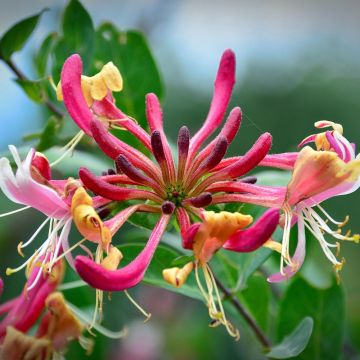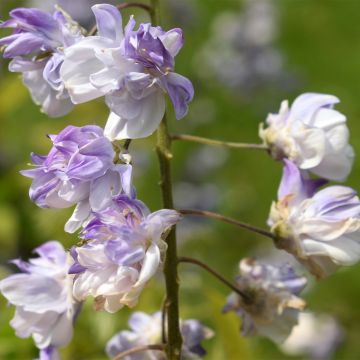

Lonicera periclymenum Chic et Choc - Common Honeysuckle


Lonicera periclymenum Chic et Choc - Common Honeysuckle


Lonicera periclymenum Chic et Choc - Common Honeysuckle


Lonicera periclymenum Chic et Choc - Common Honeysuckle


Lonicera periclymenum Chic et Choc - Common Honeysuckle


Lonicera periclymenum Chic et Choc - Common Honeysuckle
Lonicera periclymenum Chic et Choc - Common Honeysuckle
Lonicera periclymenum Chic et Choc® 'Inov205'
Common honeysuckle
After 6 months, it hasn't grown much. It flowered a little bit.
Sonia , 14/10/2025
Special offer!
Receive a €20 voucher for any order over €90 (excluding delivery costs, credit notes, and plastic-free options)!
1- Add your favorite plants to your cart.
2- Once you have reached €90, confirm your order (you can even choose the delivery date!).
3- As soon as your order is shipped, you will receive an email containing your voucher code, valid for 3 months (90 days).
Your voucher is unique and can only be used once, for any order with a minimum value of €20, excluding delivery costs.
Can be combined with other current offers, non-divisible and non-refundable.
Home or relay delivery (depending on size and destination)
Schedule delivery date,
and select date in basket
This plant carries a 6 months recovery warranty
More information
We guarantee the quality of our plants for a full growing cycle, and will replace at our expense any plant that fails to recover under normal climatic and planting conditions.
Would this plant suit my garden?
Set up your Plantfit profile →
Description
Lonicera periclymenum Chic et Choc is a variety of honeysuckle interesting for its small size, its very bushy habit and its long summer flowering, both colourful and fragrant. Throughout the summer, this small bush transforms into a ball of pinkish-white flowers that turn yellow-orange and carmine-pink, exuding a delicate fragrance. In short, this is a very different kind of honeysuckle: elegant and colourful, perfectly suited to small spaces and to growing in pots, even in areas with little sunlight.
Lonicera periclymenum Chic et Choc belongs to the Caprifoliaceae family. It is a creation of INRA dating back to 2012. Its wild ancestor, the common honeysuckle, is widespread in Europe, especially central Europe and as far north as Sweden. It is also found in North Africa. It also grows in hedges and woods, preferring siliceous soils rich in sand and humus. In nature, it develops strong twining stems of 3m (9 in 10 ft) or more that wrap around surrounding shrubs and trees. This honeysuckle has given rise to many cultivars, including 'Chic et Choc', selected for its very bushy habit and the abundance of its flowers.
This slow-growing Chic et Choc honeysuckle, with relatively slow growth, eventually forms a bush about 1m (3.3 ft) tall and with a spread of 70cm (27.6 in). Its non-climbing stems bear bluish-green, oval to lanceolate leaves, 4 to 6cm (1.6 - 2.4 in) long, on purple stems. The deciduous foliage appears in spring and falls in autumn. Abundant flowering usually starts in June and can continue until September if the plant has enough water. It takes the form of clusters of tubular, fragrant flowers, 3cm (1.2 in) long, first pinkish-white then yellow-orange and carmine-pink. They have two large, colourful lips, leaving the stamens visible. This variety rarely produces fruits which are small berries that turn red in autumn.
With its compact size and abundance of flowers, the Lonicera periclymenum Chic et Choc is ideal for container gardening, as well as in flower beds, borders or rock gardens alongside other shrubs (Japanese spireas, dwarf barberries, Deutzias, dwarf buddleias...). It also combines well with grasses (Pennisetum, Stipa), asters, gauras, or even with the stunning purple bush clematis recta Purpurea.
Report an error about the product description
Lonicera periclymenum Chic et Choc - Common Honeysuckle in pictures






Plant habit
Flowering
Foliage
Botanical data
Lonicera
periclymenum
Chic et Choc® 'Inov205'
Caprifoliaceae
Common honeysuckle
Cultivar or hybrid
Other Honeysuckle
View all →Planting and care
The Lonicera periclymenum Chic et Choc can be planted in autumn or spring in moist, rich, and well-drained soil in a sunny or partially shaded position. Compost should be added to the soil when planting. Water regularly and mulch the soil to keep it cool and moist. Watch out for aphids! It is well-suited to growing in pots: choose a 30-litre container with a hole in the bottom and a bed of clay balls or pottery shards for drainage. Use a good quality potting compost, possibly mixed with garden soil. Water regularly and apply a fertiliser for flowering shrubs from spring to summer.
Planting period
Intended location
Care
-
, onOrder confirmed
Reply from on Promesse de fleurs
Similar products
Haven't found what you were looking for?
Hardiness is the lowest winter temperature a plant can endure without suffering serious damage or even dying. However, hardiness is affected by location (a sheltered area, such as a patio), protection (winter cover) and soil type (hardiness is improved by well-drained soil).

Photo Sharing Terms & Conditions
In order to encourage gardeners to interact and share their experiences, Promesse de fleurs offers various media enabling content to be uploaded onto its Site - in particular via the ‘Photo sharing’ module.
The User agrees to refrain from:
- Posting any content that is illegal, prejudicial, insulting, racist, inciteful to hatred, revisionist, contrary to public decency, that infringes on privacy or on the privacy rights of third parties, in particular the publicity rights of persons and goods, intellectual property rights, or the right to privacy.
- Submitting content on behalf of a third party;
- Impersonate the identity of a third party and/or publish any personal information about a third party;
In general, the User undertakes to refrain from any unethical behaviour.
All Content (in particular text, comments, files, images, photos, videos, creative works, etc.), which may be subject to property or intellectual property rights, image or other private rights, shall remain the property of the User, subject to the limited rights granted by the terms of the licence granted by Promesse de fleurs as stated below. Users are at liberty to publish or not to publish such Content on the Site, notably via the ‘Photo Sharing’ facility, and accept that this Content shall be made public and freely accessible, notably on the Internet.
Users further acknowledge, undertake to have ,and guarantee that they hold all necessary rights and permissions to publish such material on the Site, in particular with regard to the legislation in force pertaining to any privacy, property, intellectual property, image, or contractual rights, or rights of any other nature. By publishing such Content on the Site, Users acknowledge accepting full liability as publishers of the Content within the meaning of the law, and grant Promesse de fleurs, free of charge, an inclusive, worldwide licence for the said Content for the entire duration of its publication, including all reproduction, representation, up/downloading, displaying, performing, transmission, and storage rights.
Users also grant permission for their name to be linked to the Content and accept that this link may not always be made available.
By engaging in posting material, Users consent to their Content becoming automatically accessible on the Internet, in particular on other sites and/or blogs and/or web pages of the Promesse de fleurs site, including in particular social pages and the Promesse de fleurs catalogue.
Users may secure the removal of entrusted content free of charge by issuing a simple request via our contact form.
The flowering period indicated on our website applies to countries and regions located in USDA zone 8 (France, the United Kingdom, Ireland, the Netherlands, etc.)
It will vary according to where you live:
- In zones 9 to 10 (Italy, Spain, Greece, etc.), flowering will occur about 2 to 4 weeks earlier.
- In zones 6 to 7 (Germany, Poland, Slovenia, and lower mountainous regions), flowering will be delayed by 2 to 3 weeks.
- In zone 5 (Central Europe, Scandinavia), blooming will be delayed by 3 to 5 weeks.
In temperate climates, pruning of spring-flowering shrubs (forsythia, spireas, etc.) should be done just after flowering.
Pruning of summer-flowering shrubs (Indian Lilac, Perovskia, etc.) can be done in winter or spring.
In cold regions as well as with frost-sensitive plants, avoid pruning too early when severe frosts may still occur.
The planting period indicated on our website applies to countries and regions located in USDA zone 8 (France, United Kingdom, Ireland, Netherlands).
It will vary according to where you live:
- In Mediterranean zones (Marseille, Madrid, Milan, etc.), autumn and winter are the best planting periods.
- In continental zones (Strasbourg, Munich, Vienna, etc.), delay planting by 2 to 3 weeks in spring and bring it forward by 2 to 4 weeks in autumn.
- In mountainous regions (the Alps, Pyrenees, Carpathians, etc.), it is best to plant in late spring (May-June) or late summer (August-September).
The harvesting period indicated on our website applies to countries and regions in USDA zone 8 (France, England, Ireland, the Netherlands).
In colder areas (Scandinavia, Poland, Austria...) fruit and vegetable harvests are likely to be delayed by 3-4 weeks.
In warmer areas (Italy, Spain, Greece, etc.), harvesting will probably take place earlier, depending on weather conditions.
The sowing periods indicated on our website apply to countries and regions within USDA Zone 8 (France, UK, Ireland, Netherlands).
In colder areas (Scandinavia, Poland, Austria...), delay any outdoor sowing by 3-4 weeks, or sow under glass.
In warmer climes (Italy, Spain, Greece, etc.), bring outdoor sowing forward by a few weeks.


















































